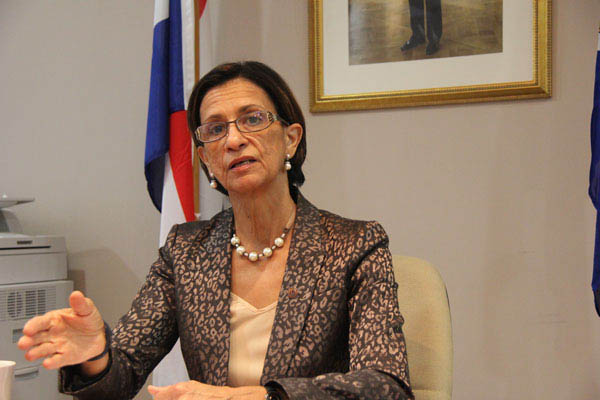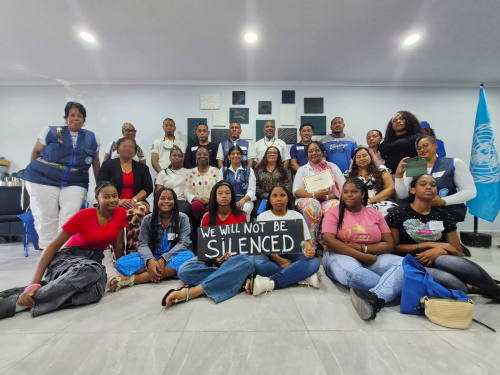 PHILIPSBURG:--- Member of Parliament Sarah A. Wescot-Williams has formally written to Prime Minister Luc F.E. Mercelina, urging the Government of Sint Maarten to move swiftly on the newly launched Livelihood Protection Policy (LPP) offered through CCRIF SPC (formerly the Caribbean Catastrophe Risk Insurance Facility).
PHILIPSBURG:--- Member of Parliament Sarah A. Wescot-Williams has formally written to Prime Minister Luc F.E. Mercelina, urging the Government of Sint Maarten to move swiftly on the newly launched Livelihood Protection Policy (LPP) offered through CCRIF SPC (formerly the Caribbean Catastrophe Risk Insurance Facility).
The LPP is a parametric micro-insurance product designed to provide rapid cash payouts to individuals, micro- and small-businesses, and vulnerable livelihood groups who suffer income loss from extreme weather events such as tropical cyclones or heavy rainfall.
MP Wescot-Williams noted that because Sint Maarten is already a member of CCRIF, the island’s micro- and small-enterprise (SME) community is eligible to benefit from this innovative protection mechanism.
“In my constant quest to ensure that Sint Maarten obtains maximum exposure and benefit from regional initiatives and programs, I believe the Livelihood Protection Policy represents an important opportunity for our small entrepreneurs and informal workers,” the MP stated.
In her letter to the Prime Minister, MP Wescot-Williams requested clarity on whether the Government has already begun engagement with CCRIF regarding the LPP. If not, she urged that immediate steps be taken to:
1. Obtain the full set of technical and regulatory details from CCRIF and its implementing partners.
2. Formally express the Government’s willingness to participate and enable LPP roll-out in Sint Maarten.
3. Launch early outreach to local insurers, small entrepreneurs, and MSME stakeholders to ensure awareness and preparedness for the program.
The MP emphasized that access to micro-insurance can significantly increase the resilience of small businesses and vulnerable workers, who often lack traditional insurance coverage yet face the greatest economic shocks after severe weather events.
“As a hurricane-prone island, Sint Maarten should be proactive in securing every additional layer of protection available for our people and our economy,” she added.
“The LPP is specifically designed for those who are most at risk and least able to absorb sudden income loss.”
MP Wescot-Williams reiterated her commitment to monitoring regional opportunities and ensuring that Sint Maarten is not left behind in programs designed to enhance social and economic resilience across the Caribbean.
BHRO host historic Human Rights Workshop as Bonerians unite to strengthen rights awareness.
 BONAIRE:--- The Human Rights Workshop held on Saturday, December 6, 2025, drew a full-to-capacity audience, with strong participation from Bonaireans and its inhabitants of all ages. The event featured a keynote address by James Finies, Founder of the Bonaire Human Rights Organization (BHRO). His remarks set the tone for a powerful and historic gathering focused on strengthening human rights awareness on the island.
BONAIRE:--- The Human Rights Workshop held on Saturday, December 6, 2025, drew a full-to-capacity audience, with strong participation from Bonaireans and its inhabitants of all ages. The event featured a keynote address by James Finies, Founder of the Bonaire Human Rights Organization (BHRO). His remarks set the tone for a powerful and historic gathering focused on strengthening human rights awareness on the island.
In a major milestone for the movement, Muhernan Fuerte PPP leaders Joseline Thielman and Phenice Frans-Piar officially joined as co-founders of bringing human rights information and education to Bonaire citizens and a renewed strength, experience, and representation to the mission of advancing human rights on Bonaire.
For the first time in Bonaire’s history, the Bonaire Human Rights Organization hosted this landmark Human Rights Lecture and Workshop under the campaign “We Also Have Rights”, in collaboration with United for Human Rights International. Local partners included We Dare To Care Foundation, Rinkon Edifikando Hóbennan na Madures Foundation, Muhernan Fuerte, Movementu Pa Kambio, and Nos Ta Futuro di Boneiru.
An important highlight of the program was an impressive presentation delivered by President Davika Bissessar Shaw, who spoke on the United Nations Universal Declaration of Human Rights. During her address, she officially launched the Ambassadorship Program of the Bonaire Human Rights Organization, opening the door for community members to become certified Human Rights Ambassadors.
Participants engaged in a dynamic program that included a human rights lecture, group workshops, campaign planning, a cultural presentation, and a short test leading to certification as Human Rights Advocates. The event concluded with a certificate ceremony celebrating newly empowered participants equipped with the knowledge and tools to promote and protect human rights on Bonaire.
This workshop also marked the launch of BHRO’s five-year campaign to advance the United Nations 2030 Sustainable Development Goals, with particular emphasis on Goal 16: Peace, Justice, and Strong Institutions, which BHRO previously presented at the margins of the 80th UN General Assembly.
For more information and to register for the next workshop on January 18th, or to become a Human Rights Ambassador, please contact BHRO.
Cell/Whatsapp: +599 786 4576 – email: This email address is being protected from spambots. You need JavaScript enabled to view it.
Bonaire Human Rights Organization
Chair of Parliament Request Ministerial Response on Building Permit Audit.
 PHILIPSBURG:--- Member of Parliament Sarah Wescot-Williams has formally written to the Minister of VROMI requesting a response to the Performance Audit on the Building Permit Process (November 2025). The audit identifies significant concerns, including outdated legislation, inconsistent application of policies, lack of transparency, integrity risks, and operational bottlenecks within the permitting system.
PHILIPSBURG:--- Member of Parliament Sarah Wescot-Williams has formally written to the Minister of VROMI requesting a response to the Performance Audit on the Building Permit Process (November 2025). The audit identifies significant concerns, including outdated legislation, inconsistent application of policies, lack of transparency, integrity risks, and operational bottlenecks within the permitting system.
Given these findings -and the fact that the Minister did not respond during the audit process- the Member of Parliament has requested:
1. A formal reaction from the Minister to the audit’s conclusions.
2. A clear implementation plan covering all recommendations issued by the General Audit Chamber.
3. A detailed timeline for actions such as automation of the permitting process, legislative modernization, zoning implementation, and improvements to transparency and integrity safeguards.
According to the Member of Parliament, these reforms are essential to restoring public trust, ensuring a fair and accountable permitting system, and supporting sustainable development for Sint Maarten. A response from the Minister is requested within 3 weeks.
Statement from Minister of Justice Nathalie Tackling on State of Affairs.
 PHILIPSBURG:--- In a direct address to the people of Sint Maarten, Minister of Justice Nathalie Tackling, supported by Chief of Police Carl John and Chief Prosecutor Mannon Ridderbeks, outlined the comprehensive measures being taken to combat the recent surge in robberies and enhance public safety.
PHILIPSBURG:--- In a direct address to the people of Sint Maarten, Minister of Justice Nathalie Tackling, supported by Chief of Police Carl John and Chief Prosecutor Mannon Ridderbeks, outlined the comprehensive measures being taken to combat the recent surge in robberies and enhance public safety.
The Minister acknowledged the community's concerns and frustrations, reassuring the public that law enforcement has been proactively working to address the situation. "I hear your concerns, I feel your frustration, and I know the urgency," stated Minister Tackling. "We, as law enforcement, are not sitting still, and we have not been sitting still for the past months."
A multi-faceted strategy involving local, kingdom, and regional partners is already in motion. Key actions include:
- Request for Military Assistance: A request for Marine support was made in October to bolster the police force (APSM) during the high season. This process is ongoing, with the Marines set to operate under the Chief of Police's command upon arrival.
- Enhanced Investigative Capacity: To strengthen detective capabilities, a request was made in July for ten detectives from the Kingdom Cooperation Team (RST) and the Dutch National Police. In the interim, two investigators from the Marechaussee have been assisting APSM for the past four weeks, yielding positive operational results.
- Increased Police Presence: The community's call for more "blue on the streets" has been answered. There is already an increased police presence, and this will be further augmented with heightened controls across the island.
- Preventive Searches: Law enforcement has been granted enhanced powers to conduct preventive searches as a necessary public safety measure. The Minister emphasized that this is a serious step not taken lightly, but it is essential for security.
Minister Tackling also stressed that law enforcement is only one part of the solution. She called upon the community to take an active role in crime prevention, highlighting that the root causes of crime often develop within homes and neighborhoods where basic needs are unmet. "Justice cannot raise our children," she asserted. "We as a community need to stand up and we need to stand tall to make our homes and our lives safer as well. This is the only way that we can move forward and help our law enforcement in the long run."
Looking forward, the Minister made a firm case for sustained, multi-year funding to grow the police force, modernize policing techniques, expand investigative and detention capacities, and leverage technology. She declared her unapologetic advocacy for this level of investment, stating that the people of Sint Maarten deserve nothing less.
The statement concluded with a unified message:
- To the community: "Stay vigilant, support your neighbors, and if you see something, say something."
- To the officers: "Your commitment is visible."
- To government partners: "Prevention is all of our responsibility. Let's invest sustainably in safety in this country."
Minister Tackling expressed confidence that through unity, accountability, and long-term structural investment, Sint Maarten will restore stability and peace of mind. The public is encouraged to follow official government pages for further updates.
MHF Welcomes Psychiatrist Dr. Delia Deoagnes Monier Herrera to its Clinical Team
 CAY HILL:--- The Mental Health Foundation (MHF) is pleased to announce the appointment of Dr. Delia Deoagnes Monier Herrera as its newest psychiatrist.
CAY HILL:--- The Mental Health Foundation (MHF) is pleased to announce the appointment of Dr. Delia Deoagnes Monier Herrera as its newest psychiatrist.
Originally from Cuba, Dr. Herrera is a recognized general psychiatrist who earned her medical degree from the Higher Institute of Medical Sciences of Santiago de Cuba. With more than two decades of international clinical and academic experience, she brings extensive expertise that will significantly enhance MHF’s ability to meet the growing mental health needs within the community. She is fluent in English, Spanish and Creole a versatility that will help serve MHF’s diverse clients.
“It is hard to find an organization that is truly committed to the mental health of its clients. When I saw the work MHF is doing, I was very impressed,” Dr. Herrera shared. She also expressed enthusiasm for MHF’s plans to develop a future mental health facility and described her excitement to contribute to what she referred to as a “history-making project.”
Throughout her 24-year career, Dr. Herrera has served as both a medical psychiatrist and a senior lecturer, specializing in the assessment and treatment of acute and chronic psychiatric disorders. She has a strong interest in forensic psychiatry and has applied this expertise in diverse settings.
Her international background includes ten years in Tanzania, where she worked as a Senior Consultant Psychiatrist and Senior Lecturer. During this time, she conducted psychiatric clinics in prison facilities, performed comprehensive assessments, developed treatment plans for a wide range of referred patients, and provided support to hospitals, magistrates, primary health clinics, social services, and private practices.
Dr. Herrera has held several notable leadership roles, including former Head of the Psychiatry Department at Fausto Favier Hospital in Guantánamo, Cuba; Director-Coordinator of Psychiatry at Kilimanjaro Christian Medical University College in Tanzania; Head of the Psychiatry Department at Mawenzi Regional Referral Hospital in Tanzania; and Head of the Psychiatry Department at St. Joseph University and Mbewni Hospital in Tanzania.
In her clinical practice, Dr. Herrera follows the biopsychosocial model of treatment, emphasizing the importance of understanding each client’s cultural and personal background to make accurate diagnoses and establish effective treatment plans.
“I want to use all my work experience and combine my ideas with the new project MHF is developing to improve the level of psychiatric care on the island,” she said. “I also hope to apply my forensic experience here in St. Maarten to help improve the lives of inmates who are currently serving time in the island’s correctional facility.”
Dr. Herrera now joins MHF’s current psychiatrist, Dr. Ricardo Teixeira. Together, their combined expertise will strengthen the Foundation’s ability to provide accessible, comprehensive, and patient-centered mental health care.
The addition of Dr. Herrera not only expands MHF’s clinical capacity but also enhances support for the wider community.
The Mental Health Foundation extends a warm welcome to Dr. Herrera and looks forward to the meaningful impact she will bring to Sint Maarten.